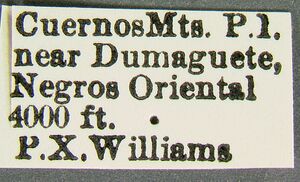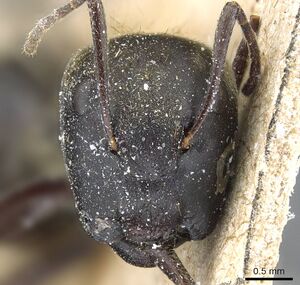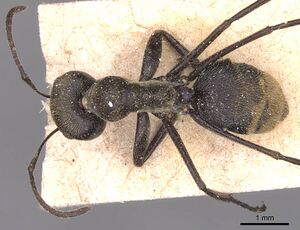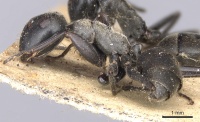Colobopsis leonardi
| Colobopsis leonardi | |
|---|---|

| |
| Scientific classification | |
| Kingdom: | Animalia |
| Phylum: | Arthropoda |
| Class: | Insecta |
| Order: | Hymenoptera |
| Family: | Formicidae |
| Subfamily: | Formicinae |
| Tribe: | Camponotini |
| Genus: | Colobopsis |
| Species: | C. leonardi |
| Binomial name | |
| Colobopsis leonardi (Emery, 1889) | |
| Subspecies | |
| |
| Synonyms | |
| |
This is a dominant species that forms large colonies in the canopy of trees. It is a member of the Colobopsis cylindrica group, a set of species that employ a novel defensive strategy. Minor workers of these so called exploding ants will, when threatened, flex their gasters so hard that they rupture. This releases a toxic chemical mixture that they then attempt to smear on their antagonists.
Identification
Keys including this Species
Distribution
Latitudinal Distribution Pattern
Latitudinal Range: 22.88333333° to -7.206667°.
| North Temperate |
North Subtropical |
Tropical | South Subtropical |
South Temperate |
- Source: AntMaps
Distribution based on Regional Taxon Lists
Indo-Australian Region: Borneo, Indonesia, Malaysia, Philippines, Singapore.
Oriental Region: India, Laos, Myanmar (type locality), Thailand.
Palaearctic Region: China.
Distribution based on AntMaps
Distribution based on AntWeb specimens
Check data from AntWeb
Countries Occupied
| Number of countries occupied by this species based on AntWiki Regional Taxon Lists. In general, fewer countries occupied indicates a narrower range, while more countries indicates a more widespread species. |

|
Estimated Abundance
| Relative abundance based on number of AntMaps records per species (this species within the purple bar). Fewer records (to the left) indicates a less abundant/encountered species while more records (to the right) indicates more abundant/encountered species. |

|
Biology
A study by Zettel et al., (2018), in southern Thailand (Khao Chong Botanical Garden, Trang Province), provided insight into the diet of this species. This field study showed that ants from the Colobobopsis cylinderica group (the exploding ants) do in fact prey on and forage for animal prey. This novel finding dispels the previous suggestion that this group of ants may not forage at all for solid food.
The studied colony was found in a fallen branch (Figure 1) of a rambutan tree (Nephelium lappaceum L., Sapindaceae). Presumably this was an arboreal nest that had fallen from the tree, but it was not clear if this was the entire colony or one of a number of nests. The branch had a total length of more than five metres and a width of about 20 cm. Nest entrances were distributed along the branch. Entrances were one or two closely positioned holes with a diameter of ca 3–5 mm. A trail between two entrances was used by foraging workers continuously and in high frequency in both directions, constituting the majority of the observed worker activity. On the morning of June 6 (2016), various termite species offered along this trail were taken by workers. These were killed by a single forager and carried away. Other insects and woodlice offered along the ant trail were also carried to the nest, with some cut into fragments before transport or only their liquid or soft inner parts consumed or carried, respectively. Pieces of earthworms were accepted as well. All of these prey items were collected from around the nesting area. No instances of suicidal defensive behaviour (autothysis) were recorded during the experiments. All small prey items were taken up with the mandibles, lifted and brought to the nest entrance by single workers. Cooperation for dragging larger items was never observed. In contrast, the transport of medium-sized items, which could be dragged but not lifted by a single worker was slowed down or made almost impossible by further workers. In one instance, a single worker tried to drag the remains of a beetle pupa to the nest, but was hindered to do so for more than 20 minutes by other workers who tried to do the same. Only when the activity on the trail became low, the worker brought the item into the nest.
Association with Other Organisms
 Explore: Show all Associate data or Search these data. See also a list of all data tables or learn how data is managed.
Explore: Show all Associate data or Search these data. See also a list of all data tables or learn how data is managed.
- This species is a host for the fungus Ophiocordyceps camponoti-leonardi (a parasitoid) (Quevillon, 2018) (encounter mode primary; direct transmission; transmission outside nest).
- This species is a host for the fungus Ophiocordyceps camponoti-leonardi (a pathogen) (Andersen, Ferrari et al., 2012; Andersen, Hughes et al., 2012; Araujo et al., 2018; Shrestha et al., 2017).
- This species is a host for the fungus Ophiocordyceps camponoti-saundersi (a parasitoid) (Quevillon, 2018) (encounter mode primary; direct transmission; transmission outside nest).
- This species is a host for the fungus Ophiocordyceps formicarum (a parasitoid) (Quevillon, 2018) (encounter mode primary; direct transmission; transmission outside nest).
- This species is a host for the fungus Ophiocordyceps formicarum (a parasitoid) (Quevillon, 2018) (encounter mode primary; direct transmission; transmission outside nest).
- This species is a host for the fungus Ophiocordyceps unilateralis (a parasitoid) (Quevillon, 2018) (encounter mode primary; direct transmission; transmission outside nest).
Castes
   
| |
| . | Owned by Museum of Comparative Zoology. |
Images from AntWeb
   
| |
| Syntype of Camponotus leonardi. Worker (major/soldier). Specimen code casent0905467. Photographer Z. Lieberman, uploaded by California Academy of Sciences. | Owned by MSNG, Genoa, Italy. |
   
| |
| Syntype of Camponotus leonardi. Worker. Specimen code casent0905468. Photographer Will Ericson, uploaded by California Academy of Sciences. | Owned by MSNG, Genoa, Italy. |
  
| |
| Syntype of Camponotus leonardi griseus. Worker. Specimen code casent0911627. Photographer Z. Lieberman, uploaded by California Academy of Sciences. | Owned by NHMB, Basel, Switzerland. |
Nomenclature
The following information is derived from Barry Bolton's Online Catalogue of the Ants of the World.
- pilosa. Formica pilosa Smith, F. 1857a: 54 (w.) BORNEO (East Malaysia: Sarawak).
- Type-material: syntype worker(s) (number not stated).
- [Note: Donisthorpe, 1932c: 443, cites 2w syntypes OXUM (confirmed by Bolton unpublished notes 1978).]
- Type-locality: Malaysia: Borneo, Sarawak, “Sar. 26” (A.R. Wallace).
- Type-depository: OXUM.
- [Junior primary homonym of Formica pilosa Olivier, 1792: 498 (Emery, 1921a: 25).]
- Combination in Colobopsis: Mayr, 1862: 691;
- combination in Camponotus: Emery, in Dalla Torre, 1893: 247;
- combination in C. (Colobopsis): Forel, 1912i: 90.
- Status as species: Smith, F. 1858b: 24; Mayr, 1863: 403; Roger, 1863b: 10; Smith, F. 1871a: 305; Dalla Torre, 1893: 247; Emery, 1896d: 378 (in list); Emery, 1900d: 706; Forel, 1912d: 110; Forel, 1913k: 133; Viehmeyer, 1914a: 115; Forel, 1915a: 42; Viehmeyer, 1916a: 161; Wheeler, W.M. 1919e: 115; Stitz, 1925: 127.
- Replacement name: Camponotus (Colobopsis) leonardi Emery, 1889b: 515.
- leonardi. Camponotus (Colobopsis) leonardi Emery, 1889b: 515.
- Replacement name for Colobopsis pubescens Mayr, 1862: 691. [Junior secondary homonym of Formica pubescens Fabricius, 1775: 392.]
- [Note: an earlier senior synonym of Colobopsis pubescens Mayr, Formica pilosa Smith, F. 1857a: 54 (synonymy by Emery, 1900d: 706), is itself a junior primary homonym (of Formica pilosa Olivier, 1792: 498); hence pilosa Smith, F. is unavailable as a replacement name for pubescens Mayr, and leonardi becomes the first available name (Emery, 1921a: 25).]
- [Misspelled as leonadi by Jaitrong & Nabhitabhata, 2005: 15.]
- Karavaiev, 1929c: 243 (m.).
- Combination in Colobopsis: Ward, Blaimer & Fisher, 2016: 350.
- Junior synonym of pubescens: Forel, 1893b: 437; Emery, 1896d: 375; Bingham, 1903: 344; Emery, 1921a: 25.
- Junior synonym of pilosus: Wheeler, W.M. 1919e: 115.
- Status as species: Dalla Torre, 1893: 248; Emery, 1895k: 480; Emery, 1896d: 375; Emery, 1900d: 706; Wheeler, W.M. 1919e: 115; Emery, 1921a: 25; Emery, 1925b: 149; Wheeler, W.M. 1927b: 46; Santschi, 1928h: 133; Karavaiev, 1929c: 243; Wheeler, W.M. 1929g: 57; Menozzi, 1930d: 328; Donisthorpe, 1932c: 443; Karavaiev, 1933a: 317; Chapman & Capco, 1951: 225; Baltazar, 1966: 269; Bolton, 1995b: 108; Jaitrong & Nabhitabhata, 2005: 15; Mohanraj, et al. 2010: 6; Pfeiffer, et al. 2011: 37; Ran & Zhou, 2011: 68; Guénard & Dunn, 2012: 29; McArthur, 2012: 44; Bharti, Guénard, et al. 2016: 25; Jaitrong, Guénard, et al. 2016: 28; Khachonpisitsak, et al. 2020: 48; Wang, W.Y., Soh, et al. 2022: 45.
- Distribution: China, India (+ Andaman Is), Indonesia (Java, Sulawesi, Sumatra), Laos, Malaysia (Peninsula, Sabah, Sarawak), Myanmar, Philippines (Luzon), Singapore, Thailand.
- Current subspecies: nominal plus gracilenta, grisea.
- pubescens. Colobopsis pubescens Mayr, 1862: 691 (q.) INDONESIA (Sulawesi).
- Type-material: holotype queen.
- Type-locality: Indonesia: Sulawesi (“Celebes”) (no collector’s name)
- Type-depository: NHMW.
- [Misspelled as pubens by Santschi, 1920h: 174, Santschi, 1924c: 115, Santschi, 1928h: 133.]
- [Junior secondary homonym of Formica pubescens Fabricius, 1775: 392.]
- Mayr, 1867a: 68 (w.).
- Status as species: Mayr, 1863: 403; Roger, 1863b: 10; Mayr, 1867a: 68 (redescription); Mayr, 1870b: 941 (in key); Forel, 1886f: 193; Emery, 1888a: 529; Forel, 1893b: 437; Dalla Torre, 1893: 248; Emery, 1893g: 267; Emery, 1896d: 375; Bingham, 1903: 344; Forel, 1903d: 408; Forel, 1907e: 19; Wheeler, W.M. 1909d: 343; Forel, 1910d: 127; Forel, 1911d: 382; Santschi, 1920h: 174; Santschi, 1924c: 115; Santschi, 1928h: 133; Mathew & Tiwari, 2000: 351 (error).
- Junior synonym of pilosa: Emery, 1900d: 706; Wheeler, W.M. 1919e: 115; Bolton, 1995b: 118.
- Replacement name: Camponotus (Colobopsis) leonardi Emery, 1889b: 515.
- [Note: an earlier senior synonym of Colobopsis pubescens Mayr, Formica pilosa Smith, F. 1857a: 54 (synonymy by Emery, 1900d: 706), is itself a junior primary homonym (of Formica pilosa Olivier, 1792: 498); hence pilosa Smith, F. is unavailable as a replacement name for pubescens Mayr, and leonardi becomes the first available name (Emery, 1921a: 25).]
Description
References
- Andersen, S.B., Ferrari, M., Evans, H.C., Elliot, S.L., Boomsma, J.J., Hughes, D.P. 2012. Disease dynamics in a specialized parasite of ant societies. PLoS ONE 7(5): e36352 (DOI 10.1371/journal.pone.0036352).
- Andersen, S.B., Hughes, D. 2012. Host specificity of parasite manipulation - Zombie ant death location in Thailand vs. Brazil. Communicative & Integrative Biology 5: 163–165 (DOI 10.4161/cib.18712).
- Araújo, J.P.M., Evans, H.C., Kepler, R., Hughes, D.P. 2018. Zombie-ant fungi across continents: 15 new species and new combinations within Ophiocordyceps. I. Myrmecophilous hirsutelloid species. Studies in Mycology 90: 119–160 (DOI 10.1016/j.simyco.2017.12.002).
- Baltazar, C.R. 1966. A catalogue of Philippine Hymenoptera (with a bibliography, 1758-1963). Pacific Insects Monographs 8: 1-488. (page 269, listed)
- Davidson, D.W., Salim, K.A., Billen, J. 2012. Histology of structures used in territorial combat by Borneo’s ‘exploding ants.’ Acta Zoologica 93, 487–491 (doi:10.1111/j.1463-6395.2011.00523.x).
- de Bekker, C., Will, I., Das, B., Adams, R.M.M. 2018. The ants (Hymenoptera: Formicidae) and their parasites: effects of parasitic manipulations and host responses on ant behavioral ecology. Myrmecological News 28: 1-24 (doi:10.25849/myrmecol.news_028:001).
- Dhadwal, T., Bharti, H. 2024. Colobopsis kapilashi sp. nov. (Hymenoptera: Formicidae) a new ant species from India with a key to the Indian species. Journal of Asia-Pacific Biodiversity (doi:10.1016/j.japb.2024.10.012).
- Emery, C. 1889d. Formiche di Birmania e del Tenasserim raccolte da Leonardo Fea (1885-87). [concl.]. Ann. Mus. Civ. Stor. Nat. 27[=(2)(7): 513-520 (page 515, pl. 11, figs. 22, 23 soldier, worker described)
- General, D.E.M., Buenavente, P.A.C., Rodriguez, L.J.V. 2020. A preliminary survey of nocturnal ants, with novel modifications for collecting nocturnal arboreal ants. Halteres 11: 1-12 (doi:10.5281/ZENODO.3707151).
- Karavaiev, V. 1929e. Ameisen aus dem Indo-Australischen Gebiet. VI. Zb. Prats Zool. Muz. 7:235-248 [= Tr. Vseukr. Akad. Nauk Fiz.-Mat. Vidd. 13:233-246]. (page 243, male described)
- Khachonpisitsak, S., Yamane, S., Sriwichai, P., Jaitrong, W. 2020. An updated checklist of the ants of Thailand (Hymenoptera, Formicidae). ZooKeys 998, 1–182 (doi:10.3897/zookeys.998.54902).
- Landrein, S., Zhou, Z.-Y., Song, S.-J. 2021. Pollinators of Hoya pottsii: Are the strongest the most effective? Flora 274, 151734 (doi:10.1016/j.flora.2020.151734).
- Liu, C., Fischer, G., Hita Garcia, F., Yamane, S., Liu, Q., Peng, Y.Q., Economo, E.P., Guénard, B., Pierce, N.E. 2020. Ants of the Hengduan Mountains: a new altitudinal survey and updated checklist for Yunnan Province highlight an understudied insect biodiversity hotspot. ZooKeys 978, 1–171 (doi:10.3897/zookeys.978.55767).
- Perfilieva, K.S. 2021. Distribution and differentiation of fossil Oecophylla (Hymenoptera: Formicidae) species by wing imprints. Paleontological Journal 55(1), 76–89 (doi:10.1134/s003103012101010x).
- Radchenko, A.G., Fisher, B.L., Esteves, F.A., Martynova, E.V., Bazhenova, T.N., Lasarenko, S.N. 2023. Ant type specimens (Hymenoptera, Formicidae) in the collection of Volodymyr Opanasovych Karawajew. Communication 1. Dorylinae, Poneromorpha and Pseudomyrmecinae. Zootaxa, 5244(1), 1–32 (doi:10.11646/zootaxa.5244.1.1).
- Rafiqi, A.M., Rajakumar, A., Abouheif, E. 2020. Origin and elaboration of a major evolutionary transition in individuality. Nature 585, 239–244. (doi:10.1038/s41586-020-2653-6).
- Shrestha B, Tanaka E, Hyun MW, Han JG, Kim CS, Jo JW, Han SK, Oh J, Sung JM, Sung GH. 2017. Mycosphere Essay 19. Cordyceps species parasitizing hymenopteran and hemipteran insects. Mycosphere 8(9): 1424–1442 (DOI 10.5943/mycosphere/8/9/8).
- Wang, W.Y., Soh, E.J.Y., Yong, G.W.J., Wong, M.K.L., Benoit Guénard, Economo, E.P., Yamane, S. 2022. Remarkable diversity in a little red dot: a comprehensive checklist of known ant species in Singapore (Hymenoptera: Formicidae) with notes on ecology and taxonomy. Asian Myrmecology 15: e015006 (doi:10.20362/am.015006).
- Ward, P.S., Blaimer, B.B., Fisher, B.L. 2016. A revised phylogenetic classification of the ant subfamily Formicinae (Hymenoptera: Formicidae), with resurrection of the genera Colobopsis and Dinomyrmex. Zootaxa 4072 (3): 343–357 (doi:10.11646/zootaxa.4072.3.4).
- Yamane, S., Tanaka, H.O., Hasimoto, Y., Ohashi, M., Meleng, P., Itioka, T. 2021. A list of ants from Lambir Hills National Park and its vicinity, with their biological information: Part II. Subfamilies Leptanillinae, Proceratiinae, Amblyoponinae, Ponerinae, Dorylinae, Dolichoderinae, Ectatomminae and Formicinae. Contributions from the Biological Laboratory, Kyoto University 31, 87–157.
- Zettel, H., Laciny, A., Jaitrong, W., Syaukani, S., Kopchinskiy, A., Druzhinina, I.S. 2018. Evidence of predation in two species of the Colobopsis cylindrica group (Hymenoptera Formicidae Camponotini). Asian Myrmecology 10 e010011 (DOI 10.20362am.010011).
References based on Global Ant Biodiversity Informatics
- Abe T., S. Yamane, and K. Onoyama. Ants collected on the Krakatau Islands 100 years after the great eruptions. Biogeography 14: 65-75.
- Andersen, S.B., S. Gerritsma, K. M. Yusah, D. Mayntz, N. L. Hywel-Jones, J. Billen, J. J. Boomsma and D. P. Hughes. 2009. Ephemeral Windows of Opportunity for Horizontal Transmission of Fungal Symbionts in Leaf-Cutting Ants. Evolution 63(9):2235-
- André E. 1892. Voyage de M. Chaper à Bornéo. Catalogue des fourmis et description des espèces nouvelles. Mém. Soc. Zool. Fr. 5: 46-55.
- Borowiec L., and S. Salata. 2019. Next step in the invasion: Trichomyrmex mayri (Forel, 1902) new to the Philippines (Hymenoptera: Formicidae). Annals of the Upper Silesian Museum in Bytom Entomology 28(3): 1-3.
- Chapman J. W. 1965. Studies on the ecology of the army ants of the Philippines genus Aenictus Schuckard (Hymenoptera: Formicidae). Philippine Journal of Science. 93: 551-595.
- Chapman, J. W., and Capco, S. R. 1951. Check list of the ants (Hymenoptera: Formicidae) of Asia. Monogr. Inst. Sci. Technol. Manila 1: 1-327
- Chen Y. Q., Q. Li, Y. L. Chen, Z. X. Lu, X. Y. Zhou. 2011. Ant diversity and bio-indicators in land management of lac insect agroecosystem in Southwestern China. Biodivers. Conserv. 20: 3017-3038.
- Emery C. 1888. Catalogo delle formiche esistenti nelle collezioni del Museo Civico di Genova. Parte terza . Formiche raccolte dal sig. Elio Modigliani in Sumatra e nell'isola Nias. Annali del Museo Civico di Storia Naturale 25: 528-534.
- Emery C. Formiche raccolte da Elio Modigliani in Sumatra, Engano e Mentawei. Annali del Museo Civico di Storia Naturale 40: 661-722.
- Emery, C.. "Formiche raccolte da Elio Modigliani in Sumatra, Engano e Mentawei." Annali del Museo Civico di Storia Naturale Giacomo Doria (Genova) (2) 20, no. 40 (1900): 661-722.
- Fontanilla A. M., A. Nakamura, Z. Xu, M. Cao, R. L. Kitching, Y. Tang, and C. J. Burwell. 2019. Taxonomic and functional ant diversity along tropical, subtropical, and subalpine elevational transects in southwest China. Insects 10, 128; doi:10.3390/insects10050128
- Forel A. 1886. Études myrmécologiques en 1886.. Annales de la Société Entomologique de Belgique. 30: 131-215.
- Forel A. 1903. Les fourmis des îles Andamans et Nicobares. Rapports de cette faune avec ses voisines. Rev. Suisse Zool. 11: 399-411.
- Forel A. 1911. Fourmis nouvelles ou intéressantes. Bull. Soc. Vaudoise Sci. Nat. 47: 331-400.
- Forel A. 1912. Ameisen aus Java beobachtet und gesammelt von Edward Jacobson. III. Theil. Notes Leyden Mus. 34: 97-112
- Forel A. 1913k. Wissenschaftliche Ergebnisse einer Forschungsreise nach Ostindien ausgeführt im Auftrage der Kgl. Preuss. Akademie der Wissenschaften zu Berlin von H. v. Buttel-Reepen. II. Ameisen aus Sumatra, Java, Malacca und Ceylon. Gesammelt von Herrn Prof. Dr. v. Buttel-Reepen in den Jahren 1911-1912. Zoologische Jahrbücher. Abteilung für Systematik, Geographie und Biologie der Tiere 36:1-148.
- Forel A. 1915. Fauna Simalurensis. Hymenoptera Aculeata, Fam. Formicidae. Tijdschr. Entomol. 58: 22-43.
- Itino T., and S. Yamane. The vertical distribution of ants on canopy trees in a Bornean lowland rainf forest. Tropics 4(2/3): 277-281.
- Jaitrong W., B. Guenard, E. P. Economo, N. Buddhakala, and S. Yamane. 2016. A checklist of known ant species of Laos (Hymenoptera: Formicidae). Asian Myrmecology 8: 1-32. DOI: 10.20362/am.008019
- Jaitrong W.; Nabhitabhata, J. 2005. A list of known ant species of Thailand. The Thailand Natural History Museum Journal 1(1): 9-54.
- Karavaiev V. 1933. Ameisen aus dem Indo-Australischen Gebiet, VII. Konowia 11: 305-320.
- Mathew R., and R. N. Tiwari. 2000. Insecta: Hymenoptera: Formicidae. Pp. 251-409 in: Director; Zoological Survey of India (ed.) 2000. Fauna of of Meghalaya. Part 7. [State Fauna Series 4.] Insecta 2000. Calcutta: Zoological Survey of India, 621 pp.
- Mohanraj P., M. Ali, and K. Veerakumari. 2010. Formicidae of the Andaman and Nicobar Islands (Indian Ocean: Bay of Bengal). Journal of Insect Science 10: Article 172
- Mohanraj, P., M. Ali and K. Veenakumari. 2010. Formicidae of the Andaman and Nicobar Islands (Indian Ocean: Bay Of Bengal). Journal of Insect Science 10:172.
- Overbeck, H. (1924). A List of Ants from Singapore and Neighbouring Places. Journal of the Malayan Branch of the Royal Asiatic Society 2 (1):25-40.
- Pfeiffer M.; Mezger, D.; Hosoishi, S.; Bakhtiar, E. Y.; Kohout, R. J. 2011. The Formicidae of Borneo (Insecta: Hymenoptera): a preliminary species list. Asian Myrmecology 4:9-58
- Ran H., and S. Y. Zhou. 2011. Checklist of Chinese Ants: the Formicomorph Subfamilies (Hymenoptera: Formicidae) (I). Journal of Guangxi Normal University: Natural Science Edition. 29(3): 65-73.
- Santschi F. 1928. Fourmis de Sumatra, récoltées par Mr. J. B. Corporaal. Tijdschrift voor Entomologie 71: 119-140.
- Smith, F.. "Catalogue of the hymenopterous insects collected at Sarawak, Borneo; Mount Ophir, Malacca; and at Singapore, by A. R. Wallace." Journal of the Proceedings of the Linnean Society of London, Zoology 2 (1857): 42-88.
- Stitz H. 1925. Ameisen von den Philippinen, den malayischen und ozeanischen Inseln. Sitzungsberichte der Gesellschaft Naturforschender Freunde zu Berlin 1923: 110-136.
- Wheeler W. M. 1909. Ants of Formosa and the Philippines. Bulletin of the American Museum of Natural History 26: 333-345.
- Wheeler W. M. 1919. The ants of Borneo. Bulletin of the Museum of Comparative Zoology 63:43-147.
- Yamane S. 2013. A Review of the ant fauna of the Krakatau Islands, Indonesia. Bull. Kitakyushu Mus. Nat. Hist. Hum. Hist. Ser: A, 11: 1-66
- Zryanin V. A. 2011. An eco-faunistic review of ants (Hymenoptera: Formicidae). In: Structure and functions of soil communities of a monsoon tropical forest (Cat Tien National Park, southern Vietnam) / A.V. Tiunov (Editor). – M.: KMK Scientific Press. 2011. 277 р.101-124.
- Pages using DynamicPageList3 parser function
- Tropical
- Fungus Associate
- Host of Ophiocordyceps camponoti-leonardi
- Host of Ophiocordyceps camponoti-saundersi
- Host of Ophiocordyceps formicarum
- Host of Ophiocordyceps unilateralis
- Species
- Extant species
- Formicidae
- Formicinae
- Camponotini
- Colobopsis
- Colobopsis leonardi
- Formicinae species
- Camponotini species
- Colobopsis species




